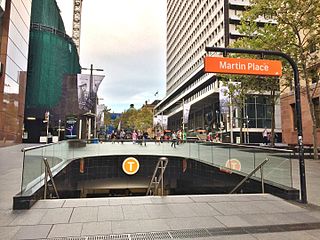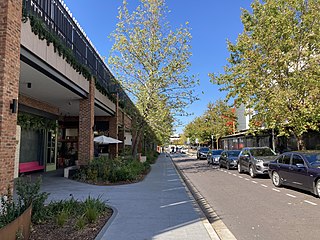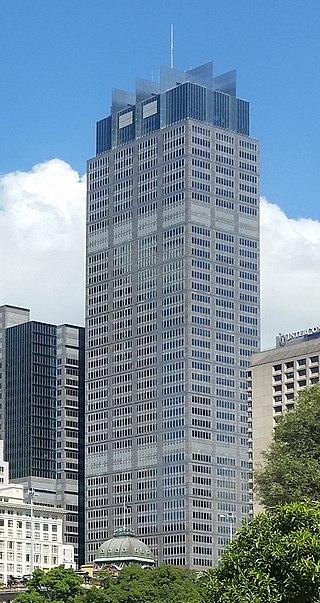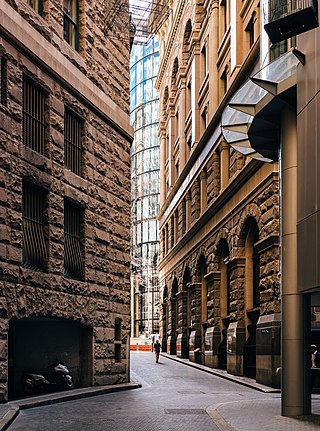
25 Martin Place is a skyscraper in Sydney, Australia. Originally named the "MLC Centre" after MLC Limited, and still commonly referred to by that name, in 2021 the name was removed by its owner, Dexus, which now refers to the building simply by its street address of 25 Martin Place.

Broadway is a 700-metre (2,300 ft) road in inner city Sydney, New South Wales, Australia. The road constitutes the border between the suburbs of Ultimo and Chippendale. Broadway is also an urban locality.

Republic Plaza is a skyscraper in Downtown Core, Singapore. It comprises two towers and a 10-storey podium. The first tower, Republic Plaza I, has 66 floors and a height of 280 metres (920 ft), and has a varying octagonal-cross section, while its interior allows for flexible space usage by tenants. The second tower, Republic Plaza II, is 23 stories tall, while the podium contains a three-floor retail area.

Martin Place railway station is a heritage-listed underground suburban rail and rapid transit station located on the Eastern Suburbs line, serving the Sydney central business district in New South Wales, Australia. Named after Martin Place, it is served by Sydney Trains's T4 Eastern Suburbs & Illawarra Line services, NSW TrainLink's South Coast Line services and Sydney Metro's North West & Bankstown Line services. It was designed by Fowell, Mansfield Jarvis and McLurcan and built from 1973 to 1979. It was added to the New South Wales State Heritage Register on 2 April 1999.

Woden Town Centre is the town centre of the district of Woden Valley in the Australian Capital Territory. It is located in the suburb of Phillip. The town centre has a variety of shops and amenities, including office blocks that house Australian departments, and shopping centres like Westfield Woden.

The Truist Center is a 47-story, 659 feet (201 m) skyscraper in Uptown Charlotte, North Carolina. The city's third tallest building, it is located along North Tryon Street. It was opened on November 14, 2002, and was the city's second tallest building, and was known as the "Hearst Tower" until 2019. The structure is composed of a 32-story tower resting atop a 15-floor podium. During Bank of America's occupancy in the building located on the podium was a three-story trading facility designed by Skidmore, Owings & Merrill and operated by Bank of America. The trading facility included a 6,000-square-foot (560 m2), two-story trading floor. Now the former trading floor is part of Truist's 100,000 square feet (9,300 m2) technology innovation center. The building is currently the headquarters of Truist Financial, which purchased the building in March 2020.

Australia Square Tower is an office and retail skyscraper in the Sydney central business district, Australia. Its main address is 264 George Street, and the square is bounded on the northern side by Bond Street, eastern side by Pitt Street and southern side by Curtin Place.

Aurora Place is a commercial skyscraper and residential block on Phillip Street in Sydney, Australia. Designed by Renzo Piano, the 41-storey building stands at a height of 218 m (715 ft) high to the top of the spire and 188 m (617 ft) to the roof.

Governor Phillip Tower, Governor Macquarie Tower and the Museum of Sydney are the main elements of a large development in the Sydney central business district in the state of New South Wales, Australia. Completed in 1994, the property development complex occupies an elevated site in the north-east area of the central business district. The complex incorporates the site of the first Government House, one of Australia's earliest and most significant sites of European heritage. The address is 1 Farrer Place. Designed by architects Denton Corker Marshall and built by Grocon, at the time of its completion it was regarded as achieving new standards for Sydney commercial architecture in terms of finish quality and design.

Suncorp Place is a skyscraper located in Sydney, Australia on Grosvenor and Lang Street. It was initially designed for Qantas by architects Joseland & Gilling positioned as Sydney's equivalent to the World Trade Centre.

Deutsche Bank Place is a 240-metre-high (790 ft), 39-storey skyscraper in Sydney, New South Wales, Australia. It is located at 126 Phillip Street in the north-eastern end of the central business district, across the road from Chifley Tower. Construction began in 2002 and was completed in 2005. The building's architect is Norman Foster of Foster and Partners.

Westfield Sydney is a large, upmarket shopping centre in the Sydney central business district. It is located underneath Sydney Tower and is located on Pitt Street Mall, adjacent to MidCity and Glasshouse, and near The Strand Arcade.

Phillip Street is a street in the central business district of Sydney in New South Wales, Australia. While the street runs from King Street in the south to Circular Quay in the north, the present street is effectively in two sections, separated by Chifley Square. Other cross streets include Martin Place, Bridge Street, and Bent Street. It is the hotspot of Sydney's legal elite.

International Plaza is a high-rise commercial and residential building at 10 Anson Road in Tanjong Pagar, within the Downtown Core of Singapore, next to Tanjong Pagar MRT station on the East West line.

Brookfield Place is a skyscraper within the Brookfield Place office complex in Perth, Western Australia. It is currently the second tallest building in Western Australia. Located at 125 St Georges Terrace, the major tenant is BHP.

Qantas House is an Australian heritage-listed office building at 68–96 Hunter Street, Sydney. It was designed by Rudder, Littlemore & Rudder and built from 1955 to 1957 by Concrete Constructions Pty Ltd. It is also known as No. 1 Chifley Square. The site was added to the New South Wales State Heritage Register on 25 May 2001.

The lanes and alleyways of Sydney are a series of passageways found in Sydney central business district that have historically functioned by providing both off-street vehicular access to city buildings and secondary pedestrian routes through city blocks. They generally feature street art, cafes, restaurants, bars and retail outlets. The Rocks has the most prominent and historical laneways in Sydney, which date to the 19th century. Forgotten Songs is a popular attraction found in Angel Place.




















